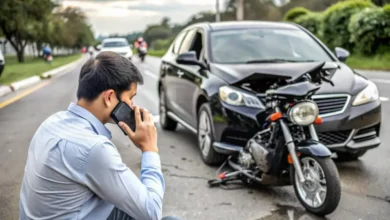Automobile Insurance Law in the United States
Learn about U.S. automobile insurance law, mandatory vehicle insurance coverage, types of insurance required by law, and top insurance providers in 2024.

- Conhecimento é poder
- O Futuro do possível
- Hibs e os fãs do Ross County na final
- Dica do dia: Aquele homem de novo
- Hibs e os fãs do Ross County na final
- Atenção perigo de falta de corte
Automobile Insurance Law in the United States. Owning and driving a vehicle in the United States comes with several responsibilities, one of the most important being securing proper automobile insurance.
Automobile insurance laws vary across states, but the underlying principle is universal: to protect drivers, passengers, and third parties from the financial consequences of accidents and damage.
This article will explore the fundamentals of automobile insurance law in the United States, detailing the legal requirements, types of insurance, and key providers.
We’ll also explain which insurance is mandatory and its legal basis, while also offering insights into finding the best insurance policies.
What Is Automobile Insurance Law?
Automobile insurance law in the United States is a legal framework that mandates drivers to have certain types of coverage in case of accidents or damage.
These laws vary from state to state, but they typically follow a similar structure, with some requiring more comprehensive coverage than others.
Automobile insurance laws ensure that drivers can cover the costs of damage or injuries they cause while operating their vehicles.
Each state sets its own requirements regarding which types of insurance are mandatory and the minimum coverage limits.
Mandatory Automobile Insurance in the United States
Each state in the U.S. requires drivers to have some form of liability insurance. Liability insurance covers damages to other people’s property or injuries they may sustain in an accident caused by the policyholder.
However, the specifics of these laws vary significantly from one state to another.
Types of Mandatory Insurance
There are two primary categories of automobile insurance coverage that are required in most U.S. states:
- Liability Insurance – This is the most common form of mandatory insurance in the U.S. Liability insurance covers:
- Bodily Injury Liability (BIL): Covers medical expenses, lost wages, and other related costs for individuals injured in an accident caused by the policyholder.
- Property Damage Liability (PDL): Covers the costs of repairing or replacing the property (usually vehicles) of others damaged in an accident for which the policyholder is at fault.
- Personal Injury Protection (PIP) – Required in “no-fault” states, this insurance covers medical expenses for the policyholder and passengers, regardless of who is at fault in an accident. States like Florida and New York require PIP.
- Uninsured/Underinsured Motorist Coverage (UM/UIM) – In many states, drivers are required to carry uninsured or underinsured motorist coverage. This ensures the policyholder is protected if they are involved in an accident with someone who lacks adequate insurance.
The Legal Basis for Mandatory Automobile Insurance
The requirement for drivers to carry insurance is established under state law. While there is no federal mandate for car insurance, each state enforces its own regulations.
The legal justification for requiring insurance is that operating a motor vehicle poses inherent risks, and the state has a vested interest in protecting its citizens from the financial burdens that result from accidents.
Requiring drivers to carry insurance helps ensure that victims of accidents can recover costs related to injuries, lost wages, and property damage.
Some states have more stringent requirements. For instance, California’s Vehicle Code Section 16020 mandates that all drivers maintain financial responsibility, typically met by purchasing automobile insurance.
Similarly, Florida Statutes Section 627.736 outlines the requirement for personal injury protection (PIP) coverage in the state.
Different Types of Automobile Insurance Coverage
Apart from the mandatory liability, PIP, and UM/UIM coverage, there are other types of vehicle insurance available in the U.S. that, while not always required, offer additional protection:
- Collision Coverage – Covers the cost of repairing or replacing the policyholder’s vehicle after an accident, regardless of fault.
- Comprehensive Coverage – Protects against non-accident-related incidents like theft, vandalism, fire, and weather-related damage (e.g., hail or floods).
- Medical Payments Coverage (MedPay) – Similar to PIP but optional in most states, this covers medical expenses for the policyholder and passengers regardless of fault.
- Gap Insurance – Helps cover the difference between what the vehicle is worth and what the policyholder owes on their car loan in the event of a total loss.
- Roadside Assistance and Rental Reimbursement – Optional add-ons that cover expenses related to breakdowns or renting a vehicle after an accident.
State-by-State Minimum Insurance Requirements
The minimum automobile insurance coverage varies across states. Below is a table highlighting minimum liability limits for some of the largest states:
| State | Bodily Injury Liability (per person) | Bodily Injury Liability (per accident) | Property Damage Liability |
|---|---|---|---|
| California | $15,000 | $30,000 | $5,000 |
| Florida | Not required (PIP only) | Not required | $10,000 |
| New York | $25,000 | $50,000 | $10,000 |
| Texas | $30,000 | $60,000 | $25,000 |
| Illinois | $25,000 | $50,000 | $20,000 |
Best Automobile Insurance Providers in the U.S.
Choosing the right insurance provider is crucial, as prices, coverage options, and customer service can vary significantly.
Here are some of the best automobile insurance providers in the U.S., known for their reliability and competitive rates:
- State Farm
- Overview: One of the largest automobile insurers in the U.S., known for excellent customer service.
- Strength: Offers a wide range of coverage options and discounts.
- Availability: Nationwide.
- Geico
- Overview: Geico is well-known for offering some of the lowest rates in the country.
- Strength: Simple, fast online quotes and comprehensive digital services.
- Availability: Nationwide.
- Progressive
- Overview: Progressive is known for its “Name Your Price” tool, which helps customers find policies within their budget.
- Strength: Competitive rates for high-risk drivers.
- Availability: Nationwide.
- Allstate
- Overview: Allstate is a popular choice for drivers who prefer working with an agent.
- Strength: Wide range of policy options and excellent local agent support.
- Availability: Nationwide.
- USAA
- Overview: USAA is widely regarded as one of the best insurance providers for military families.
- Strength: Excellent customer service and coverage tailored to military personnel.
- Availability: Restricted to military families.
How to Find Affordable Automobile Insurance Rates
Finding affordable insurance requires a combination of research, comparison, and an understanding of the factors that influence rates. Some tips for reducing insurance costs include:
- Shop Around: Get quotes from multiple insurance providers to compare rates.
- Bundle Insurance Policies: Combining home and auto insurance can lead to significant discounts.
- Improve Your Driving Record: Avoiding accidents and tickets over time can reduce your premium.
- Raise Your Deductible: A higher deductible generally lowers the premium but increases out-of-pocket costs in case of an accident.
- Take Advantage of Discounts: Many companies offer discounts for safe driving, low mileage, good student performance, or installing anti-theft devices.
Online Resources for Automobile Insurance
With the rise of digital platforms, purchasing and managing insurance online has become easier than ever. Here are some websites where you can get automotive insurance quotes quickly:
- Geico: Known for its user-friendly online system.
- Progressive: Offers online tools like the “Name Your Price” tool.
- The Zebra: A third-party comparison site that allows users to compare quotes from multiple providers.
FAQ on Automobile Insurance Laws in the U.S.
1. Is automobile insurance mandatory in every U.S. state? Yes, all states except New Hampshire require some form of liability insurance. Even in New Hampshire, drivers must demonstrate financial responsibility.
2. What is “no-fault” insurance? In no-fault states, your own insurance covers your injuries and damage regardless of who caused the accident. Personal Injury Protection (PIP) is required in these states.
3. Can I drive without insurance? Driving without insurance in states where it’s required is illegal. Penalties may include fines, suspension of your driver’s license, and even jail time.
4. What factors affect my insurance rate? Rates are influenced by factors such as your driving record, age, vehicle type, credit score, and the coverage you choose.
5. What happens if I get into an accident with an uninsured driver? If you have uninsured motorist coverage, your policy will cover damages caused by an uninsured or underinsured driver.
Conclusion: Understanding Automobile Insurance Law
Automobile insurance laws in the United States serve to protect both drivers and the general public by ensuring that every motorist carries financial responsibility for potential damages.
While each state has its specific requirements, the overarching goal is the same: to ensure drivers can cover costs in the event of an accident.
By understanding the types of coverage available and which are mandatory in your state, you can find the best policy to protect yourself on the road.





